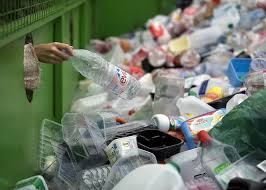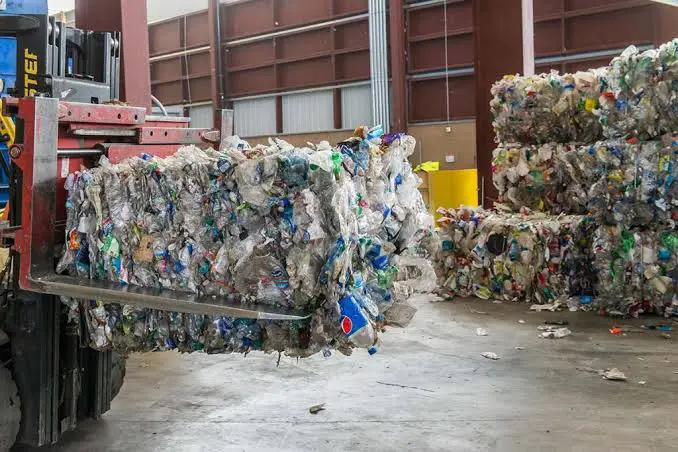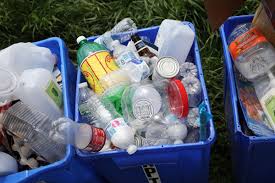Practical Steps to Convert Plastic Wastes into Plastic Lumber; Plastic containers, like bottles and bags, can be turned into something useful called plastic lumber. This plastic lumber is like wood, but it’s made from plastic. Plastic lumber is strong and durable, just like regular wood, but it’s better for the environment because it uses recycled materials.
First, the plastic containers, which are usually made of LDPE (Low-Density Polyethylene), are collected. LDPE is a type of plastic that’s flexible and commonly used for packaging things like milk jugs and grocery bags. Instead of throwing these containers away, they can be gathered up and sent to a recycling facility.
At the recycling facility, the plastic containers are sorted and cleaned. This is important to make sure that only LDPE plastic is used for making plastic lumber. Once the containers are clean and sorted, they are shredded into small pieces called pellets.
These pellets are then melted down and molded into the shape of boards. These boards look like wood, but they’re made entirely from recycled plastic! The process of turning plastic pellets into boards is called extrusion.
Once the boards are made, they can be used for all sorts of things, just like regular wood. They can be used to build decks, fences, benches, and even playground equipment. Because plastic lumber is resistant to things like water and insects, it can last a long time without needing to be replaced.
Using plastic containers to make plastic lumber is a great way to reduce waste and protect the environment. Instead of ending up in a landfill, the plastic containers are given a new life as something useful. Plus, using plastic lumber instead of traditional wood helps to conserve natural resources and reduce deforestation.
So, the next time you see a plastic container, remember that it could be turned into something amazing like plastic lumber! By recycling plastic containers, we can help create a better world for ourselves and future generations.
Read Also: Waste to Energy Business: What You Need to Know
Types of Recyclable Plastic Containers (LDPE) Wastes and their Uses

Plastic containers made from LDPE (Low-Density Polyethylene) come in various forms, each serving a specific purpose. Here are some common types of LDPE plastic containers and their potential uses:
1. Bottles: LDPE bottles are commonly used for packaging liquids such as milk, detergent, and shampoo. Once recycled, these bottles can be transformed into plastic lumber, which can be used for making outdoor furniture, decking, and playground equipment.
2. Grocery Bags: LDPE grocery bags are lightweight and flexible, making them suitable for carrying groceries and other items. When recycled, these bags can be processed into plastic lumber or used to create new plastic bags, ensuring a circular economy for plastic materials.
3. Food Packaging: LDPE is often used for packaging food items like bread, fruits, and vegetables. Recycled LDPE food packaging can be turned into plastic lumber or used for manufacturing new food containers, reducing the need for virgin plastic production.
4. Wraps and Films: LDPE wraps and films are commonly used for wrapping food items and protecting goods during transportation. After recycling, these materials can be repurposed into various products such as trash bags, agricultural films, and even composite decking materials.
5. Disposable Cutlery and Tableware: Some disposable cutlery and tableware are made from LDPE plastic. Recycling these items can help reduce single-use plastic waste and contribute to the production of plastic lumber or other durable plastic products.
6. Cosmetic and Personal Care Containers: LDPE is also used for packaging cosmetics, lotions, and personal care products. Recycled LDPE containers can be used to create new packaging materials or incorporated into plastic lumber for outdoor applications.
By properly recycling LDPE plastic containers, we can minimize the environmental impact of plastic waste and promote the sustainable use of resources. Whether it’s through the production of plastic lumber or the creation of new plastic products, recycling LDPE containers plays a vital role in conserving energy, reducing greenhouse gas emissions, and preserving natural resources for future generations.
How to Convert Plastic Containers (LDPE) Wastes into Plastic Lumber

Converting Plastic Containers (LDPE) Wastes into Plastic Lumber
1. Collection and Sorting: The first step in converting LDPE plastic containers into plastic lumber is to collect them from various sources such as recycling centers, households, and businesses. These containers are then sorted to separate LDPE plastic from other types of plastic materials.
2. Cleaning and Preparation: Once sorted, the LDPE plastic containers undergo a thorough cleaning process to remove any contaminants like dirt, labels, and residues. Cleaning is crucial to ensure the quality of the recycled material and the final product.
3. Shredding: After cleaning, the LDPE plastic containers are shredded into small pieces or flakes using shredding machines. This increases the surface area of the plastic, making it easier to melt and process in the next steps.
4. Melting and Extrusion: The shredded LDPE plastic flakes are then melted at high temperatures in an extruder. The melted plastic is forced through a die to form long, continuous strands of plastic material. These strands are cooled and solidified to create plastic pellets or resin.
5. Molding: The plastic pellets or resin are then fed into a molding machine, where they are heated and compressed into the desired shape of plastic lumber boards. The boards can be made in various sizes and dimensions to suit different applications.
6. Cooling and Finishing: Once molded, the plastic lumber boards are cooled and trimmed to the required length. They may also undergo additional finishing processes such as sanding or embossing to enhance their appearance and texture.
7. Quality Control: Throughout the manufacturing process, quality control measures are implemented to ensure that the plastic lumber meets the required standards for strength, durability, and appearance. Samples of the plastic lumber boards are tested for various properties such as tensile strength, impact resistance, and color consistency.
8. Packaging and Distribution: The final step involves packaging the plastic lumber boards and distributing them to customers for use in various applications such as outdoor decking, fencing, furniture, and landscaping. Proper packaging helps protect the plastic lumber during transportation and storage.
By following these steps, plastic containers made from LDPE can be effectively recycled and transformed into durable plastic lumber, providing a sustainable alternative to traditional wood products while reducing the environmental impact of plastic waste.
The Benefits of Converting Plastic Containers (LDPE) Wastes into Plastic Lumber
The Benefits of Converting Plastic Containers (LDPE) Wastes into Plastic Lumber
1. Environmental Preservation: Converting LDPE plastic containers into plastic lumber helps reduce the amount of plastic waste that ends up in landfills or pollutes the environment. By recycling these materials, we can conserve natural resources, reduce energy consumption, and minimize greenhouse gas emissions associated with the production of new plastic and wood products.
2. Resource Conservation: Plastic lumber made from recycled LDPE plastic requires fewer natural resources compared to traditional wood products. By utilizing recycled materials, we can help conserve forests and ecosystems, reduce deforestation, and protect biodiversity.
3. Durability and Longevity: Plastic lumber is highly durable and resistant to rot, decay, insects, and moisture. Unlike traditional wood products, plastic lumber does not require chemical treatments or frequent maintenance, resulting in long-lasting structures and reduced lifecycle costs.
4. Versatility and Adaptability: Plastic lumber can be easily molded and shaped to suit a wide range of applications, including decking, fencing, landscaping, furniture, playground equipment, and more. Its versatility allows for creative design possibilities and customization to meet specific project requirements.
5. Weather Resistance: Plastic lumber is inherently weather-resistant and can withstand harsh environmental conditions such as extreme temperatures, UV exposure, and moisture. This makes it ideal for outdoor applications where traditional wood products may deteriorate or require frequent replacement.
6. Reduced Environmental Impact: Compared to traditional wood products, plastic lumber has a lower environmental impact throughout its lifecycle. It reduces the need for logging and timber harvesting, minimizes waste generation, and lowers carbon emissions associated with manufacturing, transportation, and disposal.
7. Circular Economy: Converting LDPE plastic containers into plastic lumber promotes a circular economy by closing the loop on plastic materials. By recycling and repurposing plastic waste, we can extend the lifespan of valuable resources, reduce dependency on virgin materials, and create economic opportunities within the recycling industry.
8. Community Benefits: Recycling LDPE plastic containers into plastic lumber can create local jobs and stimulate economic growth in communities. It provides opportunities for entrepreneurship, innovation, and collaboration among stakeholders in the recycling and manufacturing sectors.
Converting LDPE plastic containers into plastic lumber offers numerous environmental, economic, and social benefits. By embracing sustainable practices and utilizing recycled materials, we can build resilient infrastructure, promote responsible consumption and production, and strive towards a more sustainable and circular economy.
Read Also: The Impact of Waste to Compost Business
The Uses and Benefits of Recycled Plastic Lumber

Recycled plastic lumber, made from materials like LDPE plastic containers, offers a wide range of uses and benefits that make it an attractive alternative to traditional wood products. Here are some of the key uses and benefits of recycled plastic lumber:
1. Outdoor Decking: Recycled plastic lumber is commonly used for building outdoor decks and patios. Its durability, weather resistance, and low maintenance requirements make it an excellent choice for decking materials. Unlike wood, plastic lumber does not rot, warp, or splinter, ensuring a long-lasting and safe outdoor space.
2. Fencing: Plastic lumber is also used for constructing fences and barriers. Its strength, durability, and resistance to pests and rot make it ideal for enclosing properties, creating privacy screens, and defining boundaries. Recycled plastic fencing is available in various styles and colors to suit different aesthetic preferences.
3. Landscaping: Recycled plastic lumber can be used for various landscaping applications, including edging, retaining walls, garden beds, and pathways. Its versatility, ease of installation, and resistance to environmental factors make it a popular choice for enhancing outdoor spaces and creating sustainable landscape designs.
4. Furniture: Plastic lumber is utilized in the manufacturing of outdoor furniture such as benches, tables, chairs, and picnic tables. Its durability, stability, and low maintenance requirements make it well-suited for withstanding the rigors of outdoor use, including exposure to sunlight, rain, and fluctuating temperatures.
5. Playground Equipment: Recycled plastic lumber is often used for constructing playground equipment such as play structures, swing sets, and climbing frames. Its strength, safety, and resistance to wear and tear make it an ideal material for creating durable and child-friendly play environments.
6. Marine Applications: Plastic lumber is suitable for marine applications such as docks, piers, and boardwalks. Its resistance to moisture, saltwater, and corrosion makes it an excellent choice for structures located near bodies of water. Recycled plastic lumber helps reduce the environmental impact of marine construction projects by utilizing recycled materials and minimizing maintenance requirements.
7. Utility Structures: Plastic lumber can be used for building utility structures such as bridges, walkways, and sound barriers. Its strength, longevity, and resistance to environmental degradation make it a reliable and cost-effective material for infrastructure projects in various settings.
8. Environmental Benefits: Using recycled plastic lumber helps divert plastic waste from landfills and reduces the demand for virgin materials. It promotes resource conservation, energy efficiency, and waste reduction, contributing to a more sustainable and circular economy. Additionally, plastic lumber does not require chemical treatments or preservatives, further reducing its environmental impact over its lifecycle.
Recycled plastic lumber offers a versatile, durable, and environmentally friendly alternative to traditional wood products. Its uses span across diverse industries and applications, providing numerous benefits in terms of performance, sustainability, and resource conservation. By embracing recycled materials and sustainable practices, we can build resilient and eco-friendly structures that benefit both present and future generations.
The Challenges of Converting Plastic Containers (LDPE) Wastes into Plastic Lumber and their Solutions
The Challenges of Converting Plastic Containers (LDPE) Wastes into Plastic Lumber and their Solutions
1. Contamination: One of the main challenges in recycling LDPE plastic containers into plastic lumber is contamination. LDPE containers may contain residues, labels, or other materials that can affect the quality of the recycled plastic.
Solutions to this challenge include implementing better sorting processes at recycling facilities, educating consumers about proper disposal methods, and investing in advanced cleaning technologies to remove contaminants more effectively.
2. Quality Control: Ensuring the consistent quality of recycled plastic lumber can be challenging due to variations in the composition and characteristics of LDPE plastic containers. Fluctuations in temperature, pressure, and processing parameters can also affect the final product quality.
Solutions involve implementing stringent quality control measures throughout the recycling and manufacturing process, conducting regular testing and inspection of raw materials and finished products, and optimizing production techniques to achieve desired performance standards.
3. Cost: Converting LDPE plastic containers into plastic lumber can be more expensive than producing traditional wood products due to the complexity of the recycling process and the investment required in specialized equipment and infrastructure.
Solutions include exploring economies of scale by increasing production volume, investing in research and development to improve process efficiency and reduce costs, and incentivizing recycling initiatives through government policies, subsidies, or tax incentives.
4. Market Demand: The demand for recycled plastic lumber may fluctuate depending on factors such as consumer preferences, market trends, and competition from other materials. Limited awareness and acceptance of recycled plastic products among consumers and businesses can also hinder market growth.
Solutions involve raising awareness about the benefits of recycled plastic lumber through marketing and educational campaigns, collaborating with stakeholders to promote sustainable procurement practices, and diversifying product offerings to meet evolving market demands.
5. Infrastructure and Logistics: Inadequate infrastructure and logistics can pose challenges in collecting, transporting, and processing LDPE plastic containers for recycling. Limited access to recycling facilities, inefficient transportation networks, and lack of standardized recycling practices can hinder the scalability and efficiency of plastic lumber recycling operations.
Solutions include investing in infrastructure development, improving collection and recycling systems through public-private partnerships, and establishing industry standards and regulations to streamline logistics and ensure compliance.
6. Technological Limitations: Existing technologies for converting LDPE plastic containers into plastic lumber may have limitations in terms of efficiency, throughput, and material compatibility.
Solutions involve investing in research and development to develop innovative recycling technologies, collaborating with academic institutions and research organizations to identify and address technological challenges, and fostering knowledge sharing and collaboration within the recycling industry to drive continuous improvement and innovation.
Through proactive measures and strategic initiatives, we can build a more resilient and circular economy that maximizes the value of plastic waste and contributes to a greener and more sustainable future.
Frequently Asked Questions (FAQs) About How to Convert Plastic Containers (LDPE) Wastes into Plastic Lumber
1. Q: What types of plastic containers can be used to make plastic lumber?
A: Plastic containers made from LDPE (Low-Density Polyethylene) are commonly used for making plastic lumber. These may include items such as milk jugs, detergent bottles, grocery bags, and food packaging.
2. Q: How are LDPE plastic containers recycled into plastic lumber?
A: The recycling process involves collecting, sorting, cleaning, shredding, melting, extruding, molding, and finishing LDPE plastic containers to produce plastic lumber boards. This process transforms recycled plastic materials into durable and sustainable building products.
3. Q: What are the benefits of using recycled plastic lumber?
A: Recycled plastic lumber offers numerous benefits, including durability, resistance to moisture and insects, low maintenance requirements, reduced environmental impact, and the conservation of natural resources. It can be used for various applications such as decking, fencing, furniture, landscaping, and playground equipment.
4. Q: How does recycled plastic lumber compare to traditional wood products?
A: Recycled plastic lumber has several advantages over traditional wood products, including greater durability, longer lifespan, resistance to rot and decay, reduced maintenance costs, and lower environmental impact. It also helps reduce the demand for virgin materials and minimize deforestation.
5. Q: Is recycled plastic lumber suitable for outdoor use?
A: Yes, recycled plastic lumber is highly suitable for outdoor use due to its weather resistance, UV stability, and resistance to moisture, rot, and insects. It can withstand harsh environmental conditions and is commonly used for decking, fencing, furniture, and other outdoor applications.
6. Q: How can I ensure the quality of recycled plastic lumber?
A: To ensure the quality of recycled plastic lumber, it’s essential to source materials from reputable suppliers, conduct regular testing and inspection of raw materials and finished products, adhere to industry standards and specifications, and implement stringent quality control measures throughout the manufacturing process.
7. Q: What can I do with recycled plastic lumber once I no longer need it?
A: Recycled plastic lumber is fully recyclable and can be returned to recycling facilities to be processed into new plastic products. Alternatively, it can be repurposed, reused, or donated for other projects or applications. Proper disposal and recycling of plastic lumber help close the loop on plastic materials and minimize waste generation.
8. Q: Are there any limitations or considerations when using recycled plastic lumber?
A: While recycled plastic lumber offers many benefits, it’s essential to consider factors such as product specifications, installation requirements, maintenance guidelines, and compatibility with existing structures or materials. It’s also important to follow manufacturer recommendations and industry best practices to ensure optimal performance and longevity.
Read Also: What Do Honey Bees Look Like
